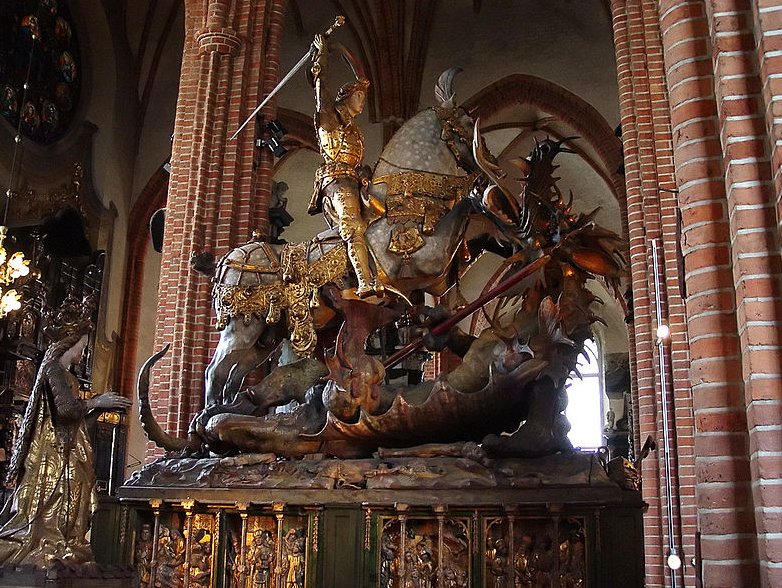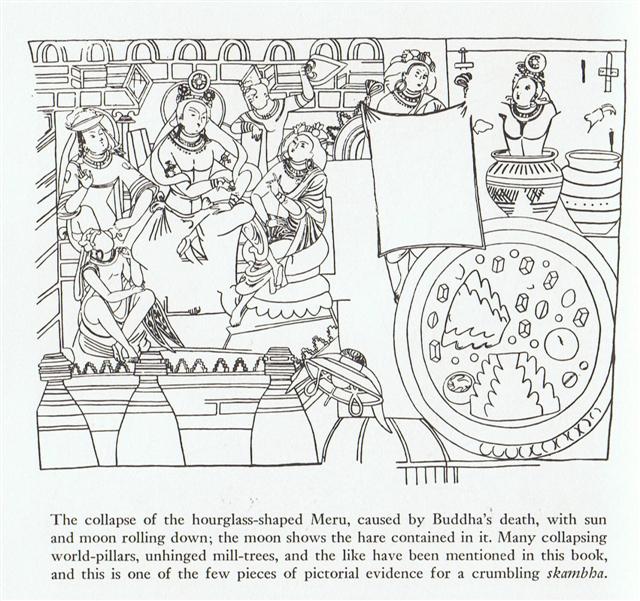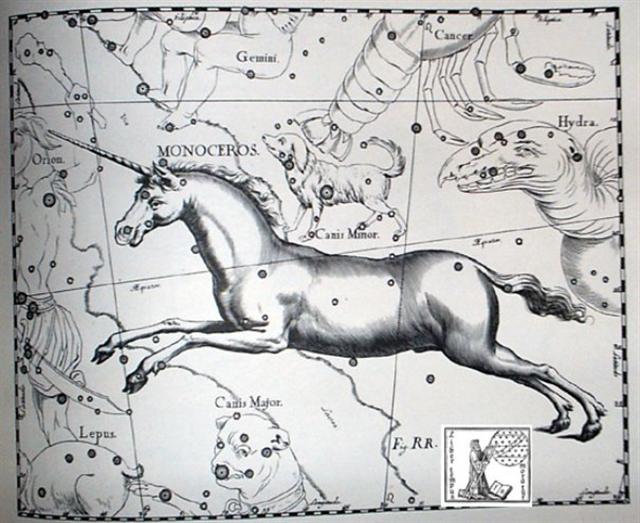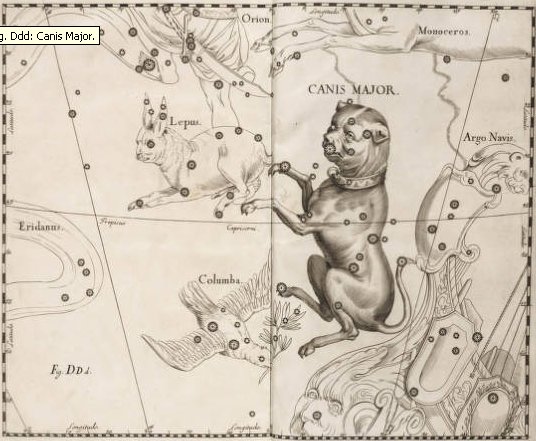Ba1.4
The Chinese tried to find out the future by
drilling holes in
the carapace of a turtle:

Such future-telling was, however, much like a game of hazard -
there was no certainty:
... Before the beginning of a new 'year' (=
halfyear) it is not yet determined what will come. According to
the Babylonian view there was a
chamber of hazard where
the sky roof meets earth ...
Likewise was the coco-nut carapace (niu)
twirled around at the beginning of the year::
... The sense of top lies in the fact that the bud end of a
coconut shell is used for spinning, both in the sport of
children and as a means of applying to island life the practical
side of the doctrine of chances. Thus it may be that in New
Zealand, in latitudes higher than are grateful to the coconut,
the divination sense has persisted even to different implements
whereby the arbitrament of fate may be declared ...
We have seen that the glyph type niu
occurs in the B text where St George encountered the Dragon
(Tiamat, etc):
|
 |
 |
|
niu |
Bb11-33 |
|
FEBR 5 (36 = 52 - 16) |
6 (466 - 64 =
402) |
11 |
FEBR 18 (414 = 65 - 16) |
54 |
APRIL 24 (485 -
16) |
 |
 |
 |
 |
|
Bb11-20 |
Bb11-21 (860) |
Bb11-33 (451) |
Bb12-45 (506) |
|
April 10 (100) |
11 (466) |
April 23 (St
George †) |
June 17 (168) |
|
The
Knee (*20) |
δ
Phoenicis (*21) |
Mira = ο Ceti (*33) |
Betelgeuze (*88) |
|
71 Virginis (*203) |
No star listed (*204) |
Khambalia (*216.4) |
Etamin (*271) |
|
Oct 10 (648 = 664
- 16) |
11 (284 = 300 - 16) |
Oct 23 (414 -
118) |
Dec 17 (351 = 9 *
39) |

At Ba1-21 something similarly drastic may have occurred, because
the central part of the glyph is absent. Or hidden:

 |
 |
|
Ba1-19 |
Ba1-20 |
|
OCT 19 (292) |
20 |
|
ι Pavonis (275.1),
POLIS
= μ Sagittarii
(275.9)
MENKAR (α Ceti) |
η Sagittarii (276.9) |
|
Dec 22 (356) |
23 |
|
CLOSE
TO THE FULL MOON: |
|
APRIL 19 |
20 (110) |
|
Al Han'ah-4 (Brand) /
Maru-sha-pu-u-mash-mashu-7 (Front of the Mouth
of the Twins)
TEJAT PRIOR =
η
Gemini (93.4),
γ
Monocerotis (93.5),
κ
Aurigae (93.6),
κ
Columbae (93.8)
*52.0 = *93.4 - *41.4 |
FURUD = ζ Canis Majoris
(94.9) |
|
June 22 |
23 (174) |
 |
 |
 |
 |
 |
|
Ba1-21 → 11 *
11 |
Ba1-22 |
Ba1-23 |
Ba1-24 |
Ba1-25 |
|
OCT 21 |
22 |
23 (296) |
24 |
25 |
|
KAUS MEDIUS = δ Sagittarii,
κ Lyrae (277.5),
TUNG HAE (Heavenly Eastern Sea) = η Serpentis
(277.7),
SHAOU PIH (Minor Minister) = φ Draconis
(277.8),
KWEI SHE = χ Draconis
(277.9) |
φ
Oct. (278.1),
KAUS AUSTRALIS =
ε
Sagittarii
(278.3),
ξ
Pavonis (278.4),
AL ATHFAR (The Talons of the Falling Eagle) =
μ
Lyrae
(278.6)
*237.0 = *278.4 - *41.4 |
KAUS BOREALIS = λ Sagittarii
(279.3) |
ν
Pavonis (280.4),
κ
Cor. Austr.
(280.9)
*239.0 = *280.4 - *41.4 |
Abhijit-22 (Victorious)
θ
Cor. Austr.
(281.0),
VEGA = α Lyrae
(281.8) |
|
Christmas Eve |
Dec 25 |
26 (360) |
27 |
28 |
|
... That the
Sun-gods Dionysus, Apollo and Mithras were all
also reputedly born at the Winter solstice is
well known, and the Christian Church first fixed
the Nativity feast of Jesus Christ at the same
season, in the year A.D. 273 [→ 3 * 91]. St.
Chrysostom, a century later, said that the
intention was that 'while the heathen were
busied with their profane rites the Christians
might perform their holy ones without
disturbance', but justified the date as suitable
for one who was 'the Sun of Righteousness' ... |
|
CLOSE
TO THE FULL MOON: |
|
APRIL 21
(111) |
22 |
23 |
24 |
25 (460 / 4) |
|
Well-22 (Tapir) /
Arkū-sha-pu-u-mash-mashu-8 (Back of the Mouth of
the Twins)
δ
Columbae (95.2),
TEJAT POSTERIOR =
μ
Gemini, MIRZAM (The Roarer) =
β
Canis Majoris (95.4),
CANOPUS (Canopy) =
α
Carinae
(95.6),
ε
Monocerotis (95.7),
ψ1
Aurigae (95.9)
*54.0 = *95.4 - *41.4 |
No star listed (96) |
β Monocerotis, ν Gemini (97.0) |
No star listed (98) |
ν Puppis (99.2),
ψ3
Aurigae (99.4),
ψ2 Aurigae (99.5)
*58.0 = *99.4 - *41.4
GEMMA (α Cor. Bor.) |
|
St John's
Day´(175) |
June 25 |
26 (354 / 2) |
27 |
28 |
|
... Midsummer
is the flowering season of the oak, which is the
tree of endurance and triumph, and like the ash
is said to 'court the lightning flash'. Its
roots are believed to extend as deep underground
as its branches rise in the air - Virgil
mentions this - which makes it emblematic of a
god whose law runs both in Heaven and in the
Underworld ... The month, which takes its name
from Juppiter the oak-god, begins on June 10th
and ends of July 7th. Midway comes St. John's
Day, June 24th, the day on which the oak-king
was sacrificially burned alive. The Celtic year
was divided into two halves with the second half
beginning in July, apparently after a seven-day
wake, or funeral feast, in the oak-king's honour
... |

 |
 |
 |
 |
 |
|
Ba1-26 |
Ba1-27 |
Ba1-28 |
Ba1-29 |
Ba1-30 |
|
OCT 26 |
27
(300) |
28 |
29 |
30 |
|
No star listed (282) |
ζ
Pavonis (283.4),
λ
Cor. Austr. (283.6),
DOUBLE DOUBLE =
ε
Lyrae
(283.7),
ζ
Lyrae (283.8)
*242.0 = *283.4 - *41.4 |
South Dipper-8 (Unicorn)
Φ
Sagittarii
(284.0),
μ
Cor. Austr. (284.6),
η
Cor. Austr.,
θ
Pavonis (284.8) |
SHELIAK (Tortoise) =
β
Lyrae,
ν
Lyrae (285.1),
ο
Draconis (285.5).
λ
Pavonis (285.7)
ATLAS (27 Tauri) |
χ
Oct. (286.0),
AIN AL RAMI (Eye of the Archer) =
ν
Sagittarii
(286.2),
υ
Draconis (286.4),
δ
Lyrae (286.3),
κ
Pavonis (286.5),
ALYA (Fat Tail) =
θ
Serpentis
(286.6)
*245.0 = *286.4 - *41.4 |
|
Dec
29 |
30
(364) |
31 |
Jan 1
(366) |
2 |
 |
|
CLOSE
TO THE FULL MOON: |
|
APRIL
26 |
27 |
28
(118) |
29 |
30
(120) |
|
ψ4 Aurigae (100.5),
MEBSUTA (Outstretched) = ε Gemini
(100.7) |
SIRIUS = α Canis Majoris
(101.2),
ψ5 Aurigae (101.4),
ν Gemini (101.6), ψ6 Aurigae (101.7)
*60.0 = *101.4 - *41.4 |
τ
Puppis (102.2),
ψ7 Aurigae (102.4)
*61.0 = *102.4 - *41.4 |
Mash-mashu-sha-Risū-9 (Twins of the
Shepherd)
θ
Gemini (103.0),
ψ8
Aurigae (103.2),
ALHENA =
γ
Gemini
(103.8),
ψ9
Aurigae (103.9) |
ADARA (Virgins) = ε Canis Majoris
(104.8) |
|
June
29 |
30
(181) |
July
1 (118 + 64) |
2 |
3 |
 |
Sirius was the pivotal point,
... The Sothic cycle was
based on what is referred to in technical jargon
as 'the periodic return of the heliacal rising
of Sirius', which is the first appearance of
this star after a seasonal absence, rising at
dawn just ahead of the sun in the eastern
portion of the sky. In the case of Sirius the
interval between one such rising and the next
amounts to exactly 365.25 days - a
mathematically harmonious figure, uncomplicated
by further decimal points, which is just twelve
minutes longer than the duration of the solar
year ... In ancient Egypt they thought Sirius
was behind the yearly rise of the Nile ... the
seasonal cycle, throughout the ancient world,
was the foremost sign of rebirth following
death, and in Egypt the chronometer of this
cycle was the annual flooding of the Nile
...
marking the center
of the Egyptian X asterism:
.jpg)
In the C text, this symbol
has been placed at the solstice in Roman
times, viz. at χ Carinae. Here was the point
of turning around from moving up to moving
down:
 |
75 |
 |
 |
40 |
 |
 |
 |
|
Ca1-1 |
Ca4-1 |
Ca4-2 (78) |
Ca5-14 |
Ca5-15 (120) |
Ca5-16 |
|
koia |
kua
tupu te rakau |
kua
tupu - te kihikihi |
kua haga te mea ke |
manu puoko i tona ahi |
kua heu te huki |
|
Sept 21 (264) |
Dec 6 |
7
(341) |
17 (341 + 41) |
18 (200 + 183) |
Jan 19 (384) |
|
CLOSE TO THE FULL MOON: |
|
Uttara Bhādrapadā-27 (2nd of the
Blessed Feet) /
Wall-14 (Porcupine)
ο Oct. (1.3),
ALGENIB PEGASI
= γ Pegasi
(1.8) |
75 |
μ Aurigae, μ Leporis (77.6) |
ĸ Leporis (78.0),
RIGEL (Foot)
= β Orionis
(78.1),
Flaming Star = IC405
(78.2),
CAPELLA
= α Aurigae
(78.4), ο Columbae, τ Orionis (78.8)
*37.0 = *78.4 - *41.4
THUBAN (α Draconis)
|
40 |
DRUS (Hard)
= χ Carinae
(119.9) |
ω Cancri (120.2) |
8h (121.7)
χ
Gemini (121.0),
NAOS (Ship)
=
ζ
Puppis
(121.3) |
|
March 22 (446) |
June 6 (157) |
7
(523) |
July 18 |
19 (200) |
20 (566) |
|
'Febr 23 (419) |
'May 10 (130) |
11 (496) |
Solstice |
'June
22 (173) |
23 |
|
"Febr 9 (405) |
"April 26 (116) |
27 (482) |
"June 7 |
8
(159) |
9 |
|
JAN 17 (382) |
APRIL 3 (93) |
4 (459) |
MAY 15 (500) |
16 (120 + 16) |
17 |
And there was a piece missing, probably
depicted as glyph (day) number 121 (→
Bharani):
|
ARIES: |
|
Ashvini
wife of the Ashvins |
β
and γ Arietis
Sheratan and Mesarthim |
Horse's head |
April 17 (107) |
|
Bharani
the bearer |
35, 39, and 41 Arietis
Musca Borealis |
Yoni, the female organ of
reproduction |
May 1 (121) |
|
TAURUS: |
|
Krittikā
the nurses of Kārttikeya |
M
45 Tauri
The Pleiades |
Knife or spear |
May 15 (135) |
|
Rohini
the red one |
α
Tauri
Aldebaran |
Cart or chariot, temple, banyan tree |
May 28 (107 + 41) |
... The four bereaved and searching divinities,
the two mothers and their two sons, were joined
by a fifth, the moon-god Thoth (who appears
sometimes in the form of an ibis-headed scribe,
at other times in the form of a baboon), and
together they found all of Osiris save his
genital member, which had been swallowed by a
fish.

They tightly swathed the broken body in
linen bandages, and when they performed over it
the rites that thereafter were to be continued
in Egypt in the ceremonial burial of kings, Isis
fanned the corpse with her wings and Osiris
revived, to become the ruler of the dead. He now
sits majestically in the underworld, in the Hall
of the Two Truths, assisted by forty-two
assessors, one from each of the principal
districts of Egypt; and there he judges the
souls of the dead. These confess before him, and
when their hearts have been weighed in a balance
against a feather, receive, according to their
lives, the reward of virtue and the punishment
of sin ...

Or as it was explained in Polynesia: there was a change
of sex:
... When this tremendous task
had been accomplished Atea took a third
husband, Fa'a-hotu, Make Fruitful. Then
occurred a curious event. Whether Atea
had wearied of bringing forth offspring we are
not told, but certain it is that Atea and
her husband Fa'a-hotu exchanged sexes.
Then the [male] eyes of Atea glanced down
at those of his wife Hotu and they begat
Ru. It was this Ru who explored
the whole earth and divided it into north,
south, east, and west ...
The reason seems to be the conjuntion between Canopus
(Agastya, Eridu) and Mirzam (β
at the right front paw of Canis Major),
cfr Ba1-21 (→ day
121 = Beltane):
... The Pythagoreans make Phaeton fall
into Eridanus, burning part of its water, and
glowing still at the time when the Argonauts
passed by. Ovid stated that since the fall the
Nile hides its sources. Rigveda 9.73.3 says that
the Great Varuna has hidden the ocean. The
Mahabharata tells in its own style why the
'heavenly Ganga' had to be brought down. At the
end of the Golden Age (Krita Yuga) a
class of Asura who had fought against the
'gods' hid themselves in the ocean where the
gods could not reach them, and planned to
overthrow the government. So the gods implored
Agastya (Canopus, alpha Carinae =
Eridu) for help. The
great Rishi did as he was bidden, drank up the
water of the ocean, and thus laid bare the
enemies, who were then slain by the gods. But
now, there was no ocean anymore! Implored by the
gods to fill the sea again, the Holy One
replied: 'That water in sooth hath been digested
by me. Some other expedient, therefore, must be
thought of by you, if ye desire to make
endeavour to fill the ocean ...

|














.jpg)






